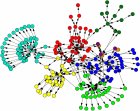
I'm very pleased and proud (actually, more relieved) to announce the third revision (v3.0) of the WJ III Evolving Web of Knowledge (EWOK), which was first announced in March of 2006. Click here to visit the original description and post. Click on the other link to go directly to the new WJ III EWOK.
Even if you do not like the Gv MindMap navigation option, I would urge you to view this "big picture" in order to see the information icons that designate branches/sections that include new material.
Feedback is always welcome.
Technorati Tags: psychology, educational psychology, education, school psychology, neuropsychology, special education, IQ, intelligene, IQ test, IQ scores, achievement, testing, WJ III, Woodcock Johnson, Normative Update, NU, Riverside Publishing
powered by performancing firefox
Even if you do not like the Gv MindMap navigation option, I would urge you to view this "big picture" in order to see the information icons that designate branches/sections that include new material.
Feedback is always welcome.
Technorati Tags: psychology, educational psychology, education, school psychology, neuropsychology, special education, IQ, intelligene, IQ test, IQ scores, achievement, testing, WJ III, Woodcock Johnson, Normative Update, NU, Riverside Publishing
powered by performancing firefox
